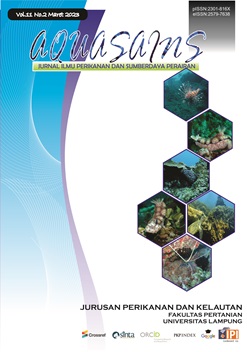OCEANOGRAPHIC OF THE FISHING GROUND FOR ANOCHVY (Stolephorus spp.) IN THE KOLONO BAY, SOUNTH KONAWE DISTRICT
DOI:
https://doi.org/10.23960/aqs.v11i2.p1343%20-%201354 Abstract View: 200
Abstract View: 200
Abstract
Kolono Bay is one of the waters in South Konawe Regency which has a large potential for fishery resources with an area of ± 9,400 hectares of water. One of the leading commodities in the waters of Kolono Bay is anchovy (Stolephorus spp). This study aims to determine the characteristics of oceanography, namely the parameters of pH, Salinity, DO (Dissolved Oxygen), current velocity, and depth of anchovy fishing area in the waters of Kolono Bay. This study uses a direct measurement method in the field. Data collection and analysis were carried out from January to March 2019 with ten research stations. The results showed that in January, February, and March in the waters of Kolono Bay, the water temperature ranged from 28.47-31.67°C. The current velocity has a range between 0.092-0.508 m/s. The value of water depth has an average value of 8.0-17 m, the average value of dissolved oxygen ranges from 4.91-7.07 mg/L, salinity with an average value of each station ranging from 32.90-35.63‰ and The degree of acidity of the water (pH) has an average of 8.00. The suggestion from this study is the need for further research on the study of status of anchovy utilization in Kolono Bay so that sustainable and sustainable management can be carried out.
Downloads
References
Adriman, A., Sumiarsih, E., & Andriani, N. (2020). Density of Mangrove Snail (Telescopium telescopium) in the Mangroves Ecosystem of Mengkapan Village, Sungai Apit Subdistrict, Siak District, Riau Province. In IOP Conference Series: Earth and Environmental Science (Vol. 430, No. 1, p. 012037). IOP Publishing.
Amiruddin. (2006). Interaksi Predasi Teri (Stolephorus spp.) Selama Proses Penangkapan Ikan Dengan Bagan Rambo: Hubungannya Dengan Kelimpahan Plankton. Tesis S2. Institut Pertanian Bogor. Bogor.
Baskoro M. (2012). Kajian Pola Arus di Darerah Penangkapan Bagan Apung di Desa Tateli Weru [Jurnal]. Fakultas Perikanan dan Ilmu Kelautan. Universitas Sam Ratulangi. Manado. Vol 1 (2): 27-32
Effendi, H. (2003). Telaah Kualitas Air: Bagi Pengelolaan Sumber Daya dan Lingkungan Perairan. Kanisius. 257 hal.
Hutabarat, S., dan M. Evans. 1984. Pengantar Oseanografi. Universitas Indonesia.Jakarta.
Jalil, A. R. (2013). Distribusi kecepatan arus pasang surut pada muson peralihan barat-timur terkait hasil tangkapan ikan pelagis kecil di perairan Spermonde. Depik, 2(1).
KMNLH. 2004. Pedoman Penetapan Baku Mutu Lingkungan, Kantor Menteri Negara Lingkungan Hidup, Keputusan Menteri Negara Lingkungan Hidup: Kep-51/MENEG LH/2004, Sekretariat Negara, Jakarta.
Laevastu, T., & Hayes, M. L. (1981). Fisheries oceanography and ecology.
Marasabessy, M.D. Edward, T. Kai-supy. 2005. Kadar Oksigen Terlarut di Ekosistem Terumbu Karang Kep. Mentawai, Nias, dan Sibolga untuk Kepentingan Biota Laut dan Pariwisata, Prosiding: Seminar Nasional Perikanan STIP, Jakarta.
Nasution, A. K., ulika Sari, T. E. Y., & Usman, U. (2015). Fishing Season Review Bilis/Teri (Stelopherus Spp) In The District of Asam Waters Strait Meranti Islands Province Riau (Doctoral dissertation, Riau University).
Nuraini R.A.T. 1997. Kepekaan Komunitas Zooplankton Terhadap Ketersediaan Bahan Organik dan Kelimpahan Fitoplankton di Tambak Bersubstrat Pasir. Tesis S2. Institut Pertanian Bogor. Bogor.
Nontji. 1993. Laut Nusantara. Penerbit Djambatan, Jakarta. 368 hlm
Omori, M dan T. Ikeda. 1984. Method in Marine Zooplankton Ecology. Krieger Pub Co. 332p.
Robert, S, L. 2012. Penentuan Daerah Potensial Penangkapan Ikan Terbang (Exocotide) Berbasis SIG dan Inderaja di Perairan Kab. Takalar. [Skripsi]. Universitas Pertanian Bogor. Bogor.
Rambe, P. R., Mubarak, M., & Rifardi, R. 2002. A Map of Sea Surface Temperature in Rupat Strait Based on Satellite Image of Aqua-Modis. Journal of Coastal and Ocean Sciences, 3(1), 54-59.
Romimohtarto, K dan Juwana, S. 2009. Biologi Laut Ilmu Pengetahuan tentang Biota laut. Djambatan. Jakarta.
Subarijanti, H. U. (2005). Ekologi Perairan. Malang: Fakultas Perikanan, Universitas Brawijaya

.png)










